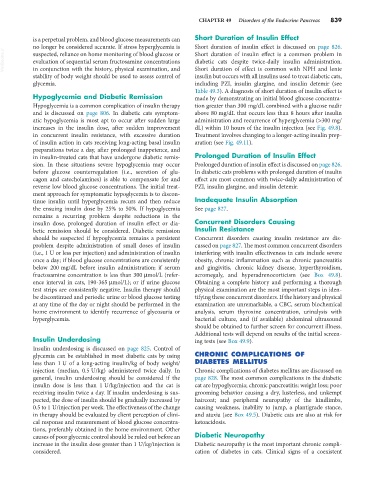Page 867 - Small Animal Internal Medicine, 6th Edition
P. 867
CHAPTER 49 Disorders of the Endocrine Pancreas 839
is a perpetual problem, and blood glucose measurements can Short Duration of Insulin Effect
no longer be considered accurate. If stress hyperglycemia is Short duration of insulin effect is discussed on page 826.
VetBooks.ir suspected, reliance on home monitoring of blood glucose or Short duration of insulin effect is a common problem in
diabetic cats despite twice-daily insulin administration.
evaluation of sequential serum fructosamine concentrations
in conjunction with the history, physical examination, and
insulin but occurs with all insulins used to treat diabetic cats,
stability of body weight should be used to assess control of Short duration of effect is common with NPH and lente
glycemia. including PZI, insulin glargine, and insulin detemir (see
Table 49.3). A diagnosis of short duration of insulin effect is
Hypoglycemia and Diabetic Remission made by demonstrating an initial blood glucose concentra-
Hypoglycemia is a common complication of insulin therapy tion greater than 300 mg/dL combined with a glucose nadir
and is discussed on page 806. In diabetic cats symptom- above 80 mg/dL that occurs less than 8 hours after insulin
atic hypoglycemia is most apt to occur after sudden large administration and recurrence of hyperglycemia (>300 mg/
increases in the insulin dose, after sudden improvement dL) within 10 hours of the insulin injection (see Fig. 49.8).
in concurrent insulin resistance, with excessive duration Treatment involves changing to a longer-acting insulin prep-
of insulin action in cats receiving long-acting basal insulin aration (see Fig. 49.11).
preparations twice a day, after prolonged inappetence, and
in insulin-treated cats that have undergone diabetic remis- Prolonged Duration of Insulin Effect
sion. In these situations severe hypoglycemia may occur Prolonged duration of insulin effect is discussed on page 826.
before glucose counterregulation (i.e., secretion of glu- In diabetic cats problems with prolonged duration of insulin
cagon and catecholamines) is able to compensate for and effect are most common with twice-daily administration of
reverse low blood glucose concentrations. The initial treat- PZI, insulin glargine, and insulin detemir.
ment approach for symptomatic hypoglycemia is to discon-
tinue insulin until hyperglycemia recurs and then reduce Inadequate Insulin Absorption
the ensuing insulin dose by 25% to 50%. If hypoglycemia See page 827.
remains a recurring problem despite reductions in the
insulin dose, prolonged duration of insulin effect or dia- Concurrent Disorders Causing
betic remission should be considered. Diabetic remission Insulin Resistance
should be suspected if hypoglycemia remains a persistent Concurrent disorders causing insulin resistance are dis-
problem despite administration of small doses of insulin cussed on page 827. The most common concurrent disorders
(i.e., 1 U or less per injection) and administration of insulin interfering with insulin effectiveness in cats include severe
once a day; if blood glucose concentrations are consistently obesity, chronic inflammation such as chronic pancreatitis
below 200 mg/dL before insulin administration; if serum and gingivitis, chronic kidney disease, hyperthyroidism,
fructosamine concentration is less than 300 µmol/L (refer- acromegaly, and hyperadrenocorticism (see Box 49.8).
ence interval in cats, 190-365 µmol/L); or if urine glucose Obtaining a complete history and performing a thorough
test strips are consistently negative. Insulin therapy should physical examination are the most important steps in iden-
be discontinued and periodic urine or blood glucose testing tifying these concurrent disorders. If the history and physical
at any time of the day or night should be performed in the examination are unremarkable, a CBC, serum biochemical
home environment to identify recurrence of glycosuria or analysis, serum thyroxine concentration, urinalysis with
hyperglycemia. bacterial culture, and (if available) abdominal ultrasound
should be obtained to further screen for concurrent illness.
Additional tests will depend on results of the initial screen-
Insulin Underdosing ing tests (see Box 49.9).
Insulin underdosing is discussed on page 825. Control of
glycemia can be established in most diabetic cats by using CHRONIC COMPLICATIONS OF
less than 1 U of a long-acting insulin/kg of body weight/ DIABETES MELLITUS
injection (median, 0.5 U/kg) administered twice daily. In Chronic complications of diabetes mellitus are discussed on
general, insulin underdosing should be considered if the page 828. The most common complications in the diabetic
insulin dose is less than 1 U/kg/injection and the cat is cat are hypoglycemia; chronic pancreatitis; weight loss; poor
receiving insulin twice a day. If insulin underdosing is sus- grooming behavior causing a dry, lusterless, and unkempt
pected, the dose of insulin should be gradually increased by haircoat; and peripheral neuropathy of the hindlimbs,
0.5 to 1 U/injection per week. The effectiveness of the change causing weakness, inability to jump, a plantigrade stance,
in therapy should be evaluated by client perception of clini- and ataxia (see Box 49.5). Diabetic cats are also at risk for
cal response and measurement of blood glucose concentra- ketoacidosis.
tions, preferably obtained in the home environment. Other
causes of poor glycemic control should be ruled out before an Diabetic Neuropathy
increase in the insulin dose greater than 1 U/kg/injection is Diabetic neuropathy is the most important chronic compli-
considered. cation of diabetes in cats. Clinical signs of a coexistent

